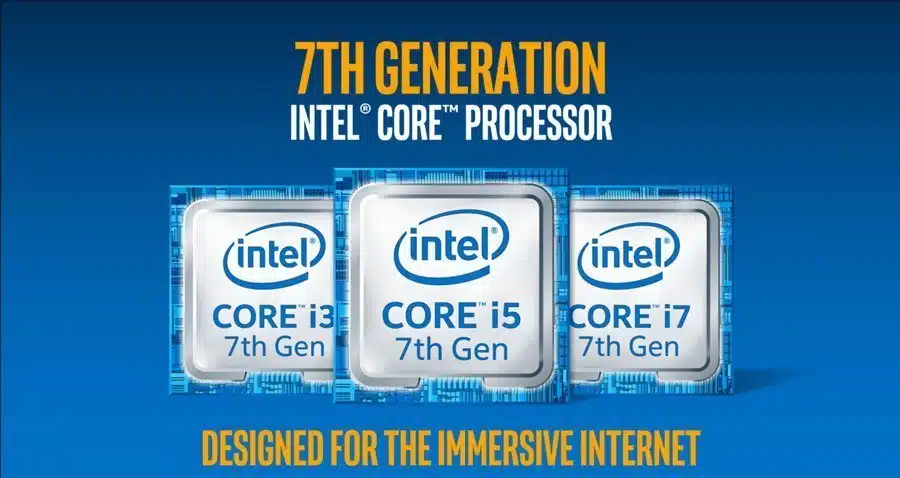
The latest Kaby Lake processors from Intel have been specifically designed keeping the progressively advancing technological improvements in mind. If you’re looking to stream/encode high resolution videos, producing rich graphical media or manipulating large CAD assemblies then look no further than the 7th Generation Kaby Lake processors.
The new architecture from Intel however, isn’t something spectacularly new. Their designs have been based on the earlier Skylake architecture. Although Intel didn’t reinvent the wheel in their 7th Generation Core i range, they did at least redefine it.
A SYSmark performance benchmark compared the productivity capabilities of a Skylake-powered computer with a 7th-Gen Kaby Lake computer, and found that the latter exceeded by twelve percent in productivity. WebXPRT recorded a nineteen percent increase in performance on the Kaby Lake when compared to its predecessor the 6th-Gen Core. Kaby Lake is destined to become favourite for those using single threaded applications due to the increase in core clock speeds. Our latest WS-X143 runs at up to 5GHz which is around a 0.5GHz increase from the previous generations.
How about transcoding a one hour 4K video in twelve minutes? The new chips come with two special decoders. The HEVC 10-bit decoding capability allows one to play back 4K videos seamlessly without any disturbances and the VP9 decoding capability takes it one step further by allowing the end user to perform multi-tasking while playing back 4K videos or 360-degree videos.
The battery life of our new WS-M mobile range (coming soon) which will take advantage of these CPU’s is expected increase due to the improved efficiency of the new 7th Gen processors.
The new CPU’s will also continue to use Intel’s Speed Shift technology. This technology makes the processor adapt the speed of the processor for optimum power efficiency, in the shortest possible time. The Speed Shift technology is the replacement for Intel’s Speed Step technology however, Speed Shift only works with compatible operating systems such as Microsoft Windows 10.
| Core i5-7600K | Core i7-7700K | |
| Cores: | 4 | 4 |
| Threads: | 4 | 8 |
| Lithography: | 14nm | 14nm |
| Base Frequency: | 3.8 GHz | 4.2 GHz |
| Boost Frequency: | 4.2 GHz | 4.5 GHz |
| DDR Support: | Dual 2,400 (DDR4) | Dual 2,400 (DDR4) |
| Intel Graphics: | HD 360 | HD 360 |
| L3 Cache: | 6 MB | 8 MB |
| TDP: | 91W | 91W |
Over Clocking the Unlocked Versions
Intel has provided extreme improvement in terms of speed in Kaby Lake; yet, it gives the power to over clock some of its desktop series processors: Core i3-7350K, Core i5-7600K, and Core i7-7700K. Kaby Lake has been designed to hit higher frequencies without the requirements of pushing up the voltage levels. The new 7th Generation processors automatically adjust the levels of voltage to make the base clock frequency more stable.
The series of transistor-level enhancements has enabled the 7th Gen processors to achieve high speeds effortlessly. An improvement can also be noticed in Turbo Boost. Whenever the chip needs to process an AVX instruction, it will automatically downclock and then return to a higher clock to receive general instructions.
Thankfully, Intel has kept a backward compatibility with 100-series chipsets, so upgrading from Skylake won’t be much of a problem here, as long as manufacturers provide a BIOS update to support the new chips.
A Russian website (OCLabs) wanted to check the ultimate performance that Core i7-7700K could deliver. So, they got on with an experiment with a Z170 motherboard and some liquid nitrogen for cooling. When the Core i7-7700K was overclocked in the Z170 motherboard, it came up with an astonishing result of 7,022.96 MHz (or 7 GHz). This speed was achieved with two cores still running. If you can afford a huge supply of liquid nitrogen then this is possible for you as well, but here at Workstation Specialists we are boasting our clock speeds to a more sustainable 5.00GHz via a liquid cooling solution.
When running at a speed of 4.25 GHz, the Core i7-7700K can get hot at around seventy two degrees Celsius while delivering peak performance and would remain at thirty two degrees Celsius when idle. It might consume up to 145W of power during peak performance and will consume 44W on an average while remaining in the idle state.
